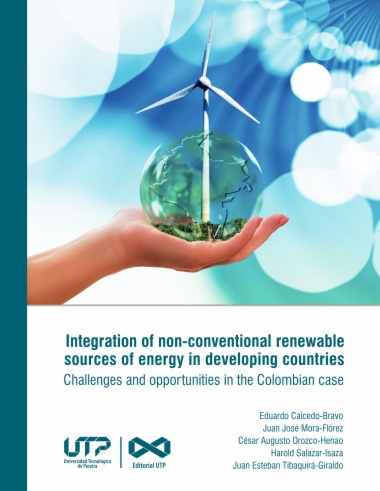Energy plays a fundamental role in developing societies worldwide, with most of its changes affecting economic progress [1]. As stated in the “Plan Nacional de Desarrollo, PND 2022-2026” chapter four, the challenges posed must drive innovation in energy transition, leading to technological advancements, greater supply capacity, and improved energy efficiency rates, including environmental aspects [2]. At the same time, global behavior shows increasing energy consumption rates, with forecasts pointing to a 49% increase in global energy consumption between 2007 and 2035. Developing countries, including Colombia, would increase their demand by 84%, while developed countries will do it by 14% [3, 4]. The previous situation implies more outstanding commitments from the developed nations. Furthermore, the environment is increasingly crucial, limiting the management and use of energy resources. Several regulations have stimulated the inclusion of new sources and technologies not previously considered in the traditional energy market. In particular, promoting non-fossil energy resources and implementing more flexible systems are becoming competitive scenarios due to successful research efforts and the consequent advancement in learning curves [3]. Therefore, global economic improvement will largely depend on technological industry changes. Reinventing energy and leveraging it to take advantage is crucial in facing the challenges ahead, and implementing these measures can build new industries, economies, and fortunes of this century
- Cover
- Title page
- Copyright page
- Contents
- Preface
- Chapter One. Introduction
- 1.1. Field of research
- 1.2. Protection challenges for NCRE integration
- 1.3. Energy efficiency indicators for the electric sector
- 1.4. Market risk influence on the inegration policies
- Chapter Two. Protection strategies for active distribution systems in the Colombian context
- 2.1. Introduction
- 2.2. Contextual background
- 2.3. ADN characteristics which most influencs the system protection
- 2.3.1 Unintentional islanding
- 2.3.2. Failure in protection devices
- 2.3.3. Blinding protection
- 2.3.4 False tripping
- 2.3.5 Automatic reclosing and synchronism
- 2.3.6. Network configuration changes
- 2.4. Approaches for ADN protection
- 2.4.1. Fault current limiters
- 2.4.2 Fault current sources
- 2.4.3. Relays with several setting groups
- 2.4.4 Adaptive protection
- 2.5. General requirements of protection strategies for ADN
- 2.5.1. Protection strategies based on communications
- 2.5.2. Protection schemes without communications
- 2.6. Current state of distribution system infrastructure in Colombia
- 2.6.1. Colombian distribution systems: a general description
- 2.6.2. Existing protection and operation schemes
- 2.7. Colombian general regulatory framework related to operation and protection in ADN
- 2.7.1 . Active distribution networks in the Colombian context: DERs integration progress
- 2.7.2. Advanced metering infrastructure
- 2.7.3. Distribution systems automation
- 2.8. Towards an implementation of ADN protection schemes in Colombia
- 2.8.1 . Stage 1: Analysis and selection of the protection scheme
- 2.8.2. Stage 2: Description of the protection scheme
- 2.8.3. Stage 3: Development of the protection scheme in a reference architectur
- 2.9. Conclusions
- Chapter Three. Energy efficiency dicators in generation, distribution, and final ue of energy in Colombia
- 3.1. Introduction
- 3.2. Brief background
- 3.3. Proposed methodology
- 3.4. Step 1: Data collection.
- 3.5. Step 1: Structure of the electric sector in Colombia
- 3.6. Step 2a: Calculation of the energy efficiency dicators in electricity generation
- 3.6.1. The efficiency of electricity generation
- 3.6.2 Primary energy intensity
- 3.6.3. Carbon emission intensity
- 3.7. Step 2c. Estimation of energy efficiency dicators in electricity distribution
- 3.7.1. Distribution system loss factor
- 3.7.2 Cost of distribution system losses
- 3.7.3 Accumulated Annual Discontinuity Index (AADI)
- 3.8. Step 2d. Energy efficiency dicators in electricity final ue
- 3.8.1. Consumption per capita
- 3.8.2. Energy intensity of the electricity final use
- 3.9. Results and discussion
- 3.9.1. Analysis of energy efficiency indicators in electricity generation
- 3.9.2. Analysis of energy efficiency indicators in electricity
distribution
- 3.9.3. Analysis of energy efficiency indicators in electricity final use
- 3.10. Conclusions
- Chapter Four. Growth of Non-Conventional Hedging Instruments: A Necessity Amid the Growth of Non-Conventional Electrical Electrical Energy Sources in Colombia Energy Sources in Colombia
- 4.1. Introduction
- 4.2. G Component of Unit Cost
- 4.2.1. Preliminaries
- 4.2.2 Generalities
- 4.3. Auctions as a mechanism to strengthen NCRE
- 4.3.1. Results of the second NCRE auction
- 4.3.2. Results of the third NCRE auction
- 4.4. Reflctions on a type of market required to harmonize the deployment of NCRE.
- Chapter Five. Concluding remarks
- 5.1. Protection challenges for NCRE integration
- 5.2. Energy efficiency dicators for the electric sector
- 5.3. Hedging instruments for the electricity market in Colombia
- References

